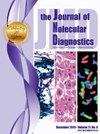4qA D4Z4甲基化检测作为fshd样表型患者鉴别诊断的有价值补充。
IF 3.4
3区 医学
Q1 PATHOLOGY
引用次数: 0
摘要
面肩肱骨肌营养不良症(FSHD)是由染色体4q35上D4Z4重复序列的多效性收缩(FSHD1)或D4Z4位点的抑制性染色质调节因子(FSHD2)突变引起的,两者都导致D4Z4序列的表观遗传失调。D4Z4重复序列的DNA甲基化已被提出用于FSHD疾病严重程度的诊断和预后;然而,需要在更大的人群中进一步验证。通过光学基因组定位(OGM)或分子梳理(MC)对247例临床疑似FSHD患者进行D4Z4分析,并检测75例患者和49例健康对照的DNA甲基化水平。在远端和全局D4Z4甲基化水平中观察到D4Z4重复序列长度依赖的非线性增加。与对照组相比,远端D4Z4甲基化水平鉴定FSHD1患者的敏感性为100%,特异性为97.96%,临界值为39.66%。在一名携带特殊D4Z4重排的受试者中也观察到远端fshd1样低甲基化,导致近端阵列收缩。临床上,远端甲基化水平与年龄校正临床严重程度评分(ACSS)和发病年龄有很强的相关性。中介分析显示,远端甲基化对ACSS的影响受发病年龄的部分介导。该研究进一步证实了远端4qA D4Z4甲基化分析作为FSHD疑似患者鉴别诊断的有价值的补充,包括那些具有复杂结构变异的患者。本文章由计算机程序翻译,如有差异,请以英文原文为准。
4qA D4Z4 Methylation Test as a Valuable Complement for Differential Diagnosis in Patients with a Facioscapulohumeral Muscular Dystrophy–Like Phenotype
Facioscapulohumeral muscular dystrophy (FSHD) is caused by pleiotropic contractions of the D4Z4 repeat array on chromosome 4q35 (FSHD1) or by mutations in repressive chromatin regulators of the D4Z4 loci (FSHD2), both resulting in epigenetic dysregulation at the D4Z4 array. DNA methylation of the D4Z4 repeat array has been proposed for diagnosis and prognosis of FSHD disease severity; however, further validation in larger populations is needed. Two hundred forty-seven clinically suspected FSHD cases were retrospectively analyzed with D4Z4 analysis by optical genome mapping or molecular combing and tested the DNA methylation levels for 75 patients and 49 healthy controls. A D4Z4 repeat length–dependent nonlinear increase was observed in both distal and global D4Z4 methylation levels. Distal D4Z4 methylation levels identified patients with FSHD1 with a sensitivity of 100% and a specificity of 97.96% at a cutoff value of 39.66% compared with controls. Distal FSHD1-like hypomethylation was also observed in one subject carrying a special D4Z4 rearrangement, resulting in a proximal contracted array. Clinically, distal methylation levels demonstrated a strong correlation with the age-corrected clinical severity score and onset age. Mediation analysis revealed that the influence of distal methylation on age-corrected clinical severity score was partially mediated by onset age. This study further confirms the distal 4qA D4Z4 methylation analysis as a valuable complement for differential diagnosis in patients with suspected FSHD, including those with complex structural variants.
求助全文
通过发布文献求助,成功后即可免费获取论文全文。
去求助
来源期刊
CiteScore
8.10
自引率
2.40%
发文量
143
审稿时长
43 days
期刊介绍:
The Journal of Molecular Diagnostics, the official publication of the Association for Molecular Pathology (AMP), co-owned by the American Society for Investigative Pathology (ASIP), seeks to publish high quality original papers on scientific advances in the translation and validation of molecular discoveries in medicine into the clinical diagnostic setting, and the description and application of technological advances in the field of molecular diagnostic medicine. The editors welcome for review articles that contain: novel discoveries or clinicopathologic correlations including studies in oncology, infectious diseases, inherited diseases, predisposition to disease, clinical informatics, or the description of polymorphisms linked to disease states or normal variations; the application of diagnostic methodologies in clinical trials; or the development of new or improved molecular methods which may be applied to diagnosis or monitoring of disease or disease predisposition.

 求助内容:
求助内容: 应助结果提醒方式:
应助结果提醒方式:


